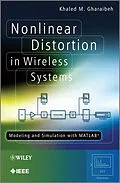This book covers the principles of modeling and simulation of nonlinear distortion in wireless communication systems with MATLAB simulations and techniques
In this book, the author describes the principles of modeling and simulation of nonlinear distortion in single and multichannel wireless communication systems using both deterministic and stochastic signals. Models and simulation methods of nonlinear amplifiers explain in detail how to analyze and evaluate the performance of data communication links under nonlinear amplification. The book addresses the analysis of nonlinear systems with stochastic inputs and establishes the performance metrics of communication systems with regard to nonlinearity. In addition, the author also discusses the problem of how to embed models of distortion in system-level simulators such as MATLAB and MATLAB Simulink and provides practical techniques that professionals can use on their own projects. Finally, the book explores simulation and programming issues and provides a comprehensive reference of simulation tools for nonlinearity in wireless communication systems.
Key Features:
* Covers the theory, models and simulation tools needed for understanding nonlinearity and nonlinear distortion in wireless systems
* Presents simulation and modeling techniques for nonlinear distortion in wireless channels using MATLAB
* Uses random process theory to develop simulation tools for predicting nonlinear system performance with real-world wireless communication signals
* Focuses on simulation examples of real-world communication systems under nonlinearity
* Includes an accompanying website containing MATLAB code
This book will be an invaluable reference for researchers, RF engineers, and communication system engineers working in the field. Graduate students and professors undertaking related courses will also find the book of interest.
Autorentext
Khaled M. Gharaibeh, Yarmouk University, Jordan
Khaled M. Gharaibeh received his B.S. and M.S. in Electrical Engineering in 1995 and 1998, respectively, both from Jordan University of Science and Technology, Irbid, Jordan. He received his Ph.D. in Electrical Engineering from North Carolina State University in 2004. From 1996 to 2000, he was a planning Engineer at Jordan Telecom, Amman, Jordan. From January 2004 to 2005, he was a research associate post-doctorate at the Department Electrical and Computer Engineering, North Carolina State University. Currently he is an Assistant Professor of Electrical Engineering at the Hijawi faculty for Engineering Technology of Yarmouk University, Irbid, Jordan. His research interests are in nonlinear system identification, behavioural modelling of nonlinear RF circuits and wireless communications. He is a senior member of the Institute of Electrical and Electronics Engineering (IEEE) and the honour society Eta Kappa Nu.
Inhalt
Preface xv
List of Abbreviations xvii
List of Figures xix
List of Tables xxvii
Acknowledgements xxix
1 Introduction 1
1.1 Nonlinearity in Wireless Communication Systems 1
1.1.1 Power Amplifiers 2
1.1.2 Low-Noise Amplifiers (LNAs) 4
1.1.3 Mixers 6
1.2 Nonlinear Distortion in Wireless Systems 6
1.2.1 Adjacent-Channel Interference 8
1.2.2 Modulation Quality and Degradation of System Performance 9
1.2.3 Receiver Desensitization and Cross-Modulation 11
1.3 Modeling and Simulation of Nonlinear Systems 12
1.3.1 Modeling and Simulation in Engineering 12
1.3.2 Modeling and Simulation for Communication System Design 14
1.3.3 Behavioral Modeling of Nonlinear Systems 15
1.3.4 Simulation of Nonlinear Circuits 16
1.4 Organization of the Book 19
1.5 Summary 20
2 Wireless Communication Systems, Standards and Signal Models 21
2.1 Wireless System Architecture 21
2.1.1 RF Transmitter Architectures 23
2.1.2 Receiver Architecture 26
2.2 Digital Signal Processing in Wireless Systems 30
2.2.1 Digital Modulation 31
2.2.2 Pulse Shaping 37
2.2.3 Orthogonal Frequency Division Multiplexing (OFDM) 39
2.2.4 Spread Spectrum Modulation 41
2.3 Mobile System Standards 45
2.3.1 Second-Generation Mobile Systems 46
2.3.2 Third-Generation Mobile Systems 48
2.3.3 Fourth-Generation Mobile Systems 51
2.3.4 Summary 51
2.4 Wireless Network Standards 52
2.4.1 First-Generation Wireless LANs 52
2.4.2 Second-Generation Wireless LANs 52
2.4.3 Third-Generation Wireless Networks (WMANs) 53
2.5 Nonlinear Distortion in Different Wireless Standards 55
2.6 Summary 56
3 Modeling of Nonlinear Systems 59
3.1 Analytical Nonlinear Models 60
3.1.1 General Volterra Series Model 60
3.1.2 Wiener Model 62
3.1.3 Single-Frequency Volterra Models 63
3.1.4 The Parallel Cascade Model 65
3.1.5 WienerHammerstein Models 66
3.1.6 Multi-Input Single-Output (MISO) Volterra Model 67
3.1.7 The Polyspectral Model 67
3.1.8 Generalized Power Series 68
3.1.9 Memory Polynomials 69
3.1.10 Memoryless Models 70
3.1.11 Power-Series Model 70
3.1.12 The Limiter Family of Models 72
3.2 Empirical Nonlinear Models 74
3.2.1 The Three-Box Model 74
3.2.2 The Abuelma'ati Model 75
3.2.3 Saleh Model 76
3.2.4 Rapp Model 76
3.3 Parameter Extraction of Nonlinear Models from Measured Data 76
3.3.1 Polynomial Models 77
3.3.2 Three-Box Model 79
3.3.3 Volterra Series 80
3.4 Summary 80
4 Nonlinear Transformation of Deterministic Signals 83
4.1 Complex Baseband Analysis and Simulations 84
4.1.1 Complex Envelope of Modulated Signals 85
4.1.2 Baseband Equivalent of Linear System Impulse Response 89
4.2 Complex Baseband Analysis of Memoryless Nonlinear Systems 90
4.2.1 Power-Series Model 92
